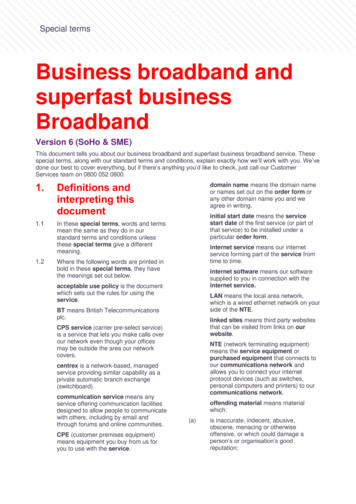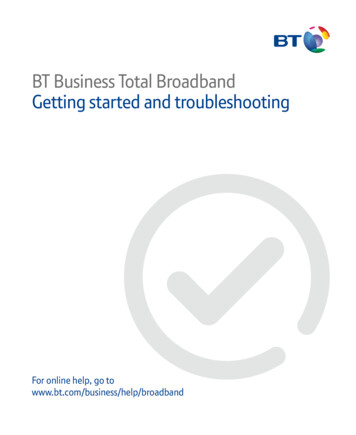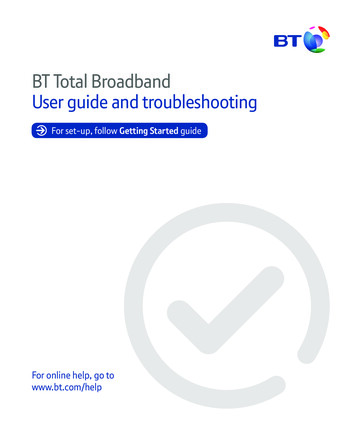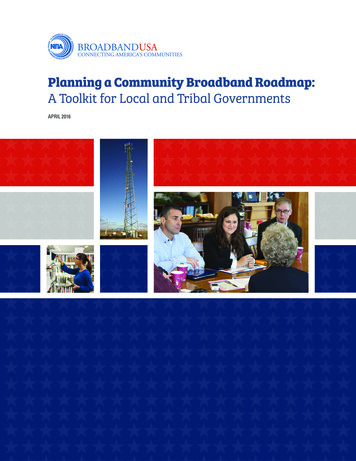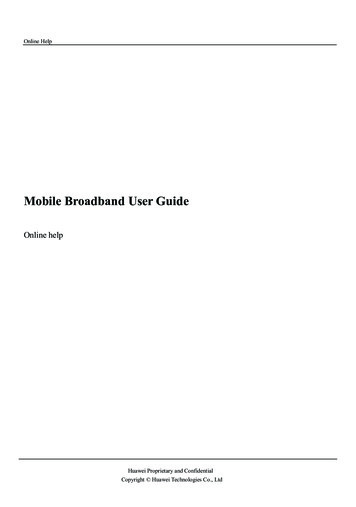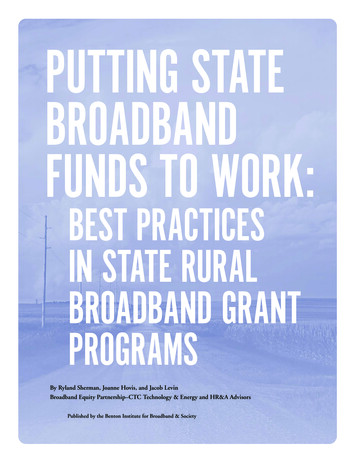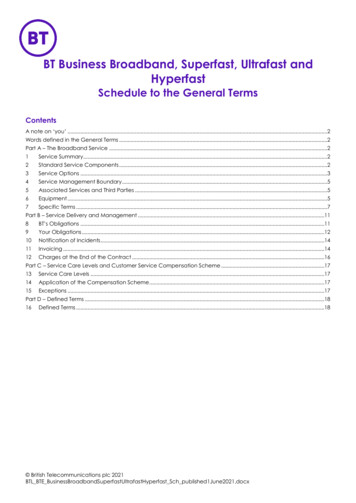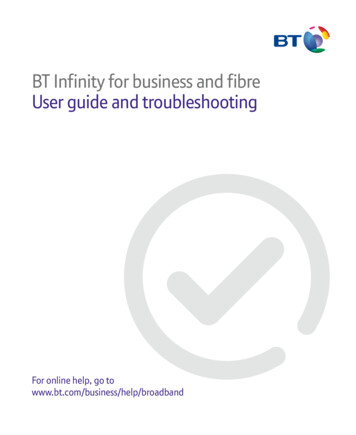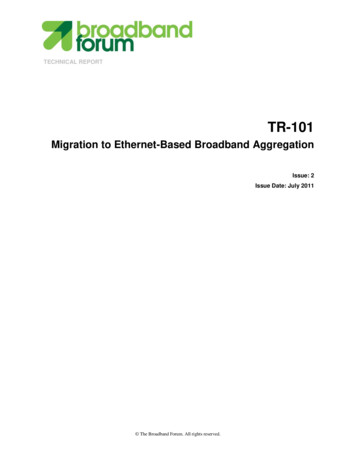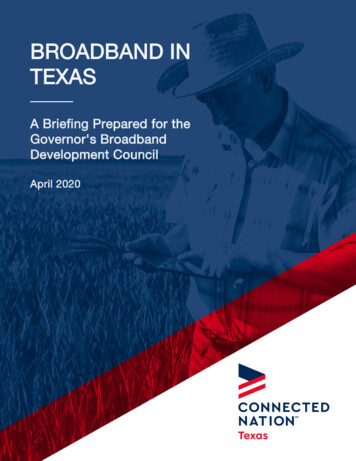
Transcription
BROADBAND INTEXASA Briefing Prepared for theGovernor's BroadbandDevelopment CouncilApril 2020Broadband in Texas1
CONTENTS01 Overview and Introduction . 5Purpose . 5About Connected Nation and Connected Nation Texas . 5Access, Adoption, and Use . 7Basic Definitions . 902 Texas’ Broadband Landscape . 12Introduction . 12A Note on Broadband Availability Data . 12Texas Broadband Definitions . 12Broadband Access . 13Internet Service Providers in Texas . 18Broadband Adoption and Usage . 1803 Federal Initiatives & Programs . 21Introduction . 21United States Department of Agriculture . 21Rural eConnectivity Pilot Program (ReConnect) . 21Community Connect Grants . 21Distance Learning & Telemedicine Grants. 22Farm Bill Broadband Loans & Loan Guarantees . 22Telecommunications Infrastructure Loans and Guarantees. 23Universal Service Fund . 24Connect America Fund . 24Lifeline . 24Schools and Libraries (E-Rate) . 25Rural Health Care . 25Rural Digital Opportunity Fund . 26Other Federal Activity . 26FirstNet . 26White House Infrastructure Plan . 27Net Neutrality . 28Broadband DATA Act . 2804 Other States . 31Best Practices . 31State Broadband Offices . 33Broadband in Texas2
CONTENTSCommon Elements . 3305 Appendix . 34A.Texas Internet Service Providers and Technology . 34B.Broadband Glossary and Table of Units. 40C.Relevant Texas Broadband Statutes . 46Broadband in Texas3
01OVERVIEW &INTRODUCTIONBroadband in Texas4
OVERVIEW &INTRODUCTION01 Overview and IntroductionPurposeToday, the success of a state has become dependent on how well it is connected to the global economyand how those connections are leveraged to improve the quality of life for its residents, the sustainabilityand growth of its businesses, the delivery of services from its many and varied institutions, and theoverall economic development of its communities. As noted in the National Broadband Plan, broadbandinternet is “a foundation for economic growth, job creation, global competitiveness, and a better way oflife.”It has been noted that it is becoming increasingly difficult in the growing e-commerce economy toconduct various forms of business transactions without internet connectivity. Concerns have beenraised that a lack of proper broadband connectivity in rural areas of Texas has left many residents at adisadvantage compared to other areas of the state, leaving rural Texans at risk of being left behind. Withthe establishment of the Governor’s Broadband Development Council (Council) through HB 1960 86(R),Governor Abbott and the legislature have taken a bold step toward a more connected Texas.The purpose of this document is to provide the Council members with a comprehensive briefing on thecurrent state of broadband in Texas, federal initiatives impacting the state and the industry, and asummary of related activity in other states around the country. This briefing is intended to offer readers abasic understanding of the broadband industry in the state and of the many federal and state efforts toexpand broadband. This information will provide a foundation to allow Council members to fulfill itsstatutory requirements.The briefing is divided into three primary sections:1. The state of broadband in Texas2. Federal broadband initiatives and programs3. Broadband efforts in other statesThe data and information in this briefing are presented with minimal exposition and analysis to providereaders with facts and a reference guide to better inform the decision-making process of developing theCouncil’s annual report and recommendations.About Connected Nation and Connected Nation TexasConnected Nation (CN) is a national 501(c)(3) organization with a core mission to improve lives throughthe expansion of technology. In 2009, CN was selected by 12 states and 1 territory as the designatedentity to lead all broadband mapping and planning efforts under the NTIA’s State Broadband Initiative(SBI). CN, through its Connected Nation Texas (CN Texas) efforts, has been working to addressbroadband and technology challenges in Texas since 2009. CN Texas partnered with the TexasDepartment of Agriculture and was commissioned to collect data from over 200 national and local Texasbroadband providers and almost 18,000 Texas community anchor institutions over the subsequent fiveyears. CN Texas also engaged over 4,000 state and local stakeholders in facilitating community leveltechnology planning.During the period between 2009 through 2015, CN Texas received 680 “broadband inquiries” comingfrom residents, business owners, and other stakeholders. The inquiries were all commonly related toBroadband in Texas5
OVERVIEW &INTRODUCTIONbroadband issues, with most inquiries coming from rural communities. Since that active project period,CN continued to receive inquires with increasing regularity. Inquiries ranged in scope and interest, butthe desperate need for broadband technology in unserved areas of the state was consistent throughout.With funding from the Still Water Foundation and in collaboration with the Texas Departmentof Agriculture, the Texas State Library and Archives Commission, and other foundations andstakeholders, CN Texas hosted a series of Listening Tours and Focus Group meetings throughout thestate from June to September 2018. The groups each met with three objectives in mind: Develop and document insights as to why communities are undersubscribing and underapplying for funds and resources that can be used for broadband technology projects Develop and share a state resource guide that could be used to identify funding and resourcesfor broadband technology projects Gather insights on broadband-related issues and possible solutions from local communityleadersOver the four-month period, CN Texas coordinated 12 Listening Tours with 10 councils of government orplanning regions across the state of Texas.Broadband in Texas6
OVERVIEW &INTRODUCTIONThe Listening Tours were intended to welcome feedback from stakeholders representing multiplesectors throughout each region. In addition to the Listening Tours, CN Texas conducted two smallFocus Group meetings with public and private entities that offer funding or resources that could be usedto support potential broadband projects. Together, these Listening Tour and Focus Group meetingsidentified a variety of issues and potential solutions to help close the digital divide in Texas and open upeconomic and quality-of-life opportunities for its rural communities. Read more about these issues andsolutions in Rural Broadband: A Texas Tour.CN Texas is supported by its parent nonprofit organization, Connected Nation. Connected Nation (CN)has over 19 years of experience providing strategic consulting and advisory services at the federal,state, and local community levels in order to accelerate and expand broadband access. CN’s strategicconsulting and advisory services provide a multi-discipline view of the broadband landscape byproviding broadband and telecommunications research, policy insights, mapping, engineering, andfederal, state, and local strategic planning services.CN has experience and a process to inform and develop a comprehensive plan with measurableoutcomes that is representative of stakeholders from multiple sectors. Evidence of state-levelengagement and comprehensive plan development includes the production of the Nevada StateBroadband Action Plan and Puerto Rico's Gigabit Island Plan. In every planning process, CN works withstate stakeholders to develop a holistic view of the broadband landscape that extends beyondbroadband infrastructure and deployment to include the present and planned adoption and use ofbroadband among residents and businesses.CN enjoys a well-informed policy staff that fully understands the telecommunications industry, drawingon years of experience working with states on broadband issues and having experience in Washington,both with the FCC and with our nation’s legislators. This experience allows for robust development ofpolicy and programs that can help pave a mutually-agreeable path toward greater availability andexpansion of broadband services.More information on Connected Nation can be found at: www.connectednation.org and ConnectedNation Texas’ website can be found at: www.connectednation.org/texas.Access, Adoption, and UseIt is recognized that in order to fully participate in a digital economy, states and communities need toaddress not only the access/availability of broadband (supply), but also the ways in which it is adoptedand used (demand) to create a truly digitally inclusive place. Wires and wireless signals are useless ifthey are not leveraged to improve civic engagement, accelerate community and economic development,retain families and youth, improve leadership, and develop human capital. CN Texas takes acomprehensive approach to broadband and technology development by addressing the access,adoption, and use of technology in a broad and deep manner.AccessBroadband access refers to the infrastructure that enables a high-speed internet connection. Broadbandis delivered to a user via several technology platforms including cable, digital subscriber line (DSL—through a phone line), fiber optics, fixed wireless, mobile wireless, and satellite. While these are currentlythe primary methods of delivery, new innovations and technologies are being developed that continue toimprove the efficiency and speed of connectivity.Broadband in Texas7
OVERVIEW &INTRODUCTIONBroadband availability is essential infrastructure for 21st century communities. Broadband empowers acommunity to access applications ranging from health care and education to business and governmentservices. Unfortunately, many places suffer from inequities of access on several fronts: between incomelevels; between urban and rural areas; between traditional business areas and non-traditional ones; andin differing levels of service due to geography or infrastructure limitations.AdoptionBroadband adoption is a different issue from broadband access. While access refers to one’s physicalconnection to the internet, broadband adoption is the choice made by a resident, business, or institutionto embrace and use broadband and its related technologies. Broadband adoption cannot occur withouthaving access to high-speed infrastructure; however, even with access to the internet, broadbandadoption may not follow.Several studies have shown that even with access to broadband, residents, businesses, and institutionsmay not adopt. Barriers to adoption often include cost (of either a device used to connect or the cost ofthe connection itself), lack of relevance to the user, or a lack of digital literacy (knowledge and skillsassociated with the use of digital hardware or software).The broadband adoption gap (the difference between the number of entities with access to broadbandand the number of those same entities that subscribe to it) can increase or decrease depending on thedemographics of a community. For example, low-income populations tend to have lower adoption ratesthan those with higher incomes. This same disparity can be found between age cohorts, physicallocations, employment status, educational levels, etc. However, regardless of socioeconomic status,demographic composition, or geographic location, everyone should have the opportunity to participatein the digital economy.UseThe access and adoption of internet technologies leads to the use of that connection and applications toimprove the quality of life for residents, businesses, and communities. Technology impacts every sectorof the economy and opportunities abound for residents, businesses, and institutions to leveragetechnology to make improvements in their day-to-day lives and operations.The wellbeing of a community involves the complex interaction of several sectors including health care,K-12 and higher education, public safety, government, libraries, residents, private-sector businesses,and others. These distinct, yet entwined, sectors (and their many individual parts and entities) contributeto a state’s place in the digital economy. As broadband and related technology have developed overtime, applications pertinent to each of these sectors have been developed that allow them to function,provide services, generate revenue, and generally operate more efficiently, which impacts theircontribution to the wellbeing of their community and state. The use of technology is critical to the impactthese sectors have on the overall quality of life in a community.While access, adoption, and use form a spectrum of sorts (i.e., one cannot adopt broadband withouthaving access to it, and one cannot use broadband without adopting it), all three components areequally important for everyone to fully realize a digitally inclusive and digitally connected state.Broadband in Texas8
OVERVIEW &INTRODUCTIONBasic DefinitionsBelow are several definitions and explanations of broadband terms and concepts that are usedfrequently in the remainder of this document. A more extensive glossary is located in Appendix B.Broadband: The term broadband commonly refers to high-speed internet access that is always on andfaster than traditional dial-up access. Broadband includes several high-speed transmissiontechnologies, such as fiber, wireless, satellite, digital subscriber line (DSL), and cable.Fixed Broadband: High-speed data transmission to homes and businesses using technologies such asT1, cable, DSL, fiber, and fixed wireless. This category excludes mobile broadband and non-terrestrialservices.Mobile Broadband: A type of internet connection designed for “on-the-go” use, with seamlessconnectivity from one geographic location to the next. Examples of mobile broadband providers inTexas include, but are not limited to, AT&T, Verizon, T-Mobile, and Sprint, among others.Cable Modem System: Cable television companies have offered internet access via their cable systemfor more than a decade. The network architecture uses a loop that connects each subscriber in a givenneighborhood, meaning they all share one big connection to the internet. Examples of cable broadbandproviders in Texas include, but are not limited to, Charter, Comcast, Grande, Sparklight (formerly CableOne), and Suddenlink, among others.DSL (Digital Subscriber Line): A form of technology that utilizes a two-wire copper telephone line to allowusers to simultaneously connect to and operate the internet and the telephone network withoutdisrupting either connection. Examples of DSL providers in Texas include, but are not limited to AT&T,CenturyLink, Earthlink, Frontier, and Windstream, among others.FTTH or FTTP (Fiber to the Home or Fiber to the Premise): The delivery and connection of fiber opticsdirectly to a home or building. Examples of fiber to the home broadband providers in Texas include, butare not limited to, AT&T Fiber, Frontier, and Google Fiber, among others.Broadband in Texas9
OVERVIEW &INTRODUCTIONFixed Wireless Broadband Access: The use of wireless devices or systems in connecting two fixedlocations, such as offices or homes. Fixed wireless broadband providers in Texas include, but are notlimited to, NextLink, Rise Broadband, VTX Communications, and TWN Communications, among others.Broadband in Texas10
02TEXAS’BROADBANDLANDSCAPEBroadband in Texas11
TEXAS’ BROADBANDLANDSCAPE02 Texas’ Broadband LandscapeIntroductionThe first step in addressing gaps in broadband access and adoption is to understand where broadbandis available, who is using it, and what prevents others from subscribing to or using broadband service.To this end, CN Texas has mapped broadband access to residences, releasing statewide and countylevel maps in January 2020. In addition, CN Texas has datasets from local surveys conducted as part ofits Connected Communities program, as well as other publicly available data that show how Texascompares to its neighbors and the rest of the nation in terms of broadband adoption and usage.A Note on Broadband Availability DataBroadband providers are required to file with the FCC a list of census blocks covered by their servicestwice annually. Under this current census block methodology, if even one household in a given block isserved, the entire block is marked as having service. In rural areas, these blocks can be extremely large,increasing the likelihood of overstatement of service in the very areas that need help the most. Forexample, nationally, there are more than 3,200 census blocks that are larger than the entire District ofColumbia (68 square miles in area) and five blocks that are larger than the entire state of Connecticut(5,567 square miles in area). Secondly, broadband providers that do not have GIS (geographicinformation system) capabilities are not able to visualize the spreadsheet-based file of census block IDsbeing filed through the FCC’s Form 477 process to ensure accuracy, resulting in overstated and/orunderstated coverage reporting. Thirdly, some providers are simply missing from the Form 477 datasetentirely. Lastly, fixed wireless coverage is also reported as full census blocks, instead of service areasdeveloped from propagation modeling, as was produced during NTIA’s State Broadband Initiativeprogram (2010-2014). The FCC continues the problematic use of census blocks as the unit of measurefor reporting, and thus accepts the well-established and inherent overstatement and understatementthat such reporting yields.CN Texas works to mitigate the census block issue in Texas by working directly with broadbandproviders to help refine their coverage areas and offer them an opportunity to provide more detailedinformation on the infrastructure availability. CN Texas employs a confidence methodology to identifyareas that are likely to be overstated and attempt to work with providers in those areas to refine theircoverage areas. However, there is no requirement for broadband providers to offer more granular data.Some broadband providers in Texas are more willing than others to offer more granular data or refinetheir coverage areas. Finally, CN Texas also conducts on-the-ground field validation of broadbandcoverage and wireless availability when possible. Drive testing and field validation offer an opportunity toreduce overstatement and create a more accurate map; however, this process is time and resourceintensive. Data displayed in map form and as tabular data is developed from a combination of directprovider outreach and data collection, FCC Form 477 filings, and independent research conducted byCN Texas. As such, broadband availability at an exact address location cannot be guaranteed, and theaggregate household availability statistics are estimates made using the most up-to-date and accurateinformation available.Texas Broadband DefinitionsBroadband is defined by Utilities Code Sec. 181.048 as internet service with the capability of providing:(A) a download speed of 25 megabits per second or faster; and (B) an upload speed of three megabitsBroadband in Texas12
TEXAS’ BROADBANDLANDSCAPEper second or faster. Broadband is also defined in Government Code Chapter 490H as a service thatprovides advanced telecommunications capability and internet access.Broadband AccessOver the years, the definition of broadband has changed significantly, as applications require fasterspeeds and new methods of delivery have been developed. Currently, the Federal CommunicationsCommission sets the benchmark for broadband as internet service with advertised speeds of at least 25Mbps downstream and 3 Mbps upstream. By this definition, over half-a-million households in Texascurrently lack access to broadband service.Over 440,000 of the half-a-million households statewide that lack access to broadband service, or 86%of Texas households that lack broadband access, are rural.Maps in this section provide information on Texas’ broadband availability at the 25 Mbps downstreamand 3 Mbps upstream speed tier, as well as the 10/1, 50/5, 100/50 Mbps speed tiers. Broadband datadisplayed on this map are developed from a combination of direct provider outreach and data collection,FCC Form 477 broadband deployment filings, and independent research conducted by ConnectedNation Texas. If a broadband provider was unwilling or unable to supply granular data and a detailedservice area could not be developed, the provider’s service availability is represented by FCC Form 477data, a format which tends to be overstated. This map is not a guarantee of internet service availability.Broadband in Texas13
TEXAS’ BROADBANDLANDSCAPEMobile and satellite services may also be available. Additionally, an interactive map of Texas’ broadbandavailability is available online at: http://map.connectednation.org/?map tx.Broadband in Texas14
TEXAS’ BROADBANDLANDSCAPEBroadband in Texas15
TEXAS’ BROADBANDLANDSCAPEBroadband in Texas16
TEXAS’ BROADBANDLANDSCAPEBroadband in Texas17
TEXAS’ BROADBANDLANDSCAPEInternet Service Providers in TexasAcross the state, Texas households are served by an estimated 333 platform options offered by anestimated 228 different providers statewide, many of which offer services under a variety of businessnames or different platforms in different parts of the state (Appendix A). While many residents along theI-35 corridor and in urban areas across the state have access to a number of terrestrial internet serviceproviders, the remainder of households often rely on fixed wireless, mobile hotspots, or satellite service.Broadband Adoption and UsageWhile more than nine out of 10 Texas households have access to broadband service, not all choose tosubscribe. According to the 2018 American Community Survey from the United States Census Bureau,only 65.6% of Texas households subscribe to fixed broadband service such as DSL, cable, or fiber athome; this places Texas below the national average of 69.6% of households and at 38th in adoptionbehind California, New York, Florida, and 34 other states. Texas does, however, have a larger share offixed broadband subscribers than any of its neighboring states.Adoption Rate:Households with Broadband Subscriptions by State, 2018(Rates include households that may or may not have access to broadband)Puerto RicoBroadband in TexasNew HampshireMassachusettsNew dWashington, DCUtahCaliforniaHawaiiRhode IslandNew ermontVirginiaNebraskaOhioArizonaIllinoisNorth CarolinaAlaskaNorth DakotaWisconsinKansasGeorgiaSouth DakotaMichiganIdahoWyomingMontanaTexas, 65.6%IowaSouth CarolinaIndianaKentuckyTennesseeWest VirginiaMissouriLouisianaNew MexicoOklahomaAlabamaArkansasMississippi18
TEXAS’ BROADBANDLANDSCAPENon-adopting households cite several reasons for their lack of connectivity; however, households withlower annual income typically struggle the most to connect. The following chart provides informationfrom a national Pew Research Center1 study designed to capture the barriers experienced byhouseholds that do not have a broadband connection.Households without Broadbandand Their Primary Barriers to Getting ConnectedOther options foraccessing theinternet outside ofthe home, 11%Monthly cost is tooexpensive21%Smartphones doeverything I need23%Computers are tooexpensive, 6%Other13%No reason given,don't know, orrefused18%Service notavailable, 5%The need for new technologies, broadband-enabled health care and digital jobs skills is increasingly vitalto the state. Research shows that Texas will need approximately 4.5 to 7.8 million new jobs to keep upwith population growth in the next 18 years. 2 Moreover, these opportunities must be made available toall Texans https://texas2036.orgBroadband in Texas19
03FEDERALINITIATIVES &PROGRAMSBroadband in Texas20
FEDERAL INITIATIVES& PROGRAMS03 Federal Initiatives & ProgramsIntroductionConnected Nation maintains a robust watchtower on broadband policy issues at the federal level. Fromregular policy briefs3 on key topics affecting stakeholders to general tracking and research onopportunities for rural development, the follow pages outline some of these issues that impact Texas.United States Department of AgricultureRural eConnectivity Pilot Program (ReConnect)ReConnect offers three types of funding options for broadband infrastructure to connect rural families,businesses, farms, ranches, schools, libraries, and public safety facilities to modern, high-speed internet.A rural area is eligible if it currently does not have sufficient access to broadband.Grants, grant and loan combinations, and low-interest loans can be used for the following: Construction or improvement of buildings, land, and other facilities that are required to providebroadband service Reasonable pre-application expenses Acquisition and improvement of an existing system that is currently providing insufficientbroadband service (eligible for 100 percent loan requests only) Terrestrial-based facilities that support the provision of satellite broadband serviceEligible applicants include most state and local governments, federally recognized tribes,commercial/internet service providers, nonprofits, small businesses, rural recipients, electric utilities andco-ops, and financial institutions. 550,000,000 is available in FY2020 and award amounts are limited as follows: 100 Percent Granto Up to 200,000,000 is available for grants. The maximum amount that can be requestedin an application is 25,000,000.50 Percent Loan/50 Percent Granto Up to 200,000,000 is available for loan/grant combinations. The maximum amount thatcan be requested in an application is 25,000,000 for the loan and 25,000,000 for thegrant. Loan and grant amounts will always be equal.100 Percent Loano Up to 200,000,000 is available for loans. The m
connection to the internet, broadband adoption is the choice made by a resident, business, or institution to embrace and use broadband and its related technologies. Broadband adoption cannot occur without having access to high-speed infrastructure; however, even with access to the internet, broadband adoption may not follow.

